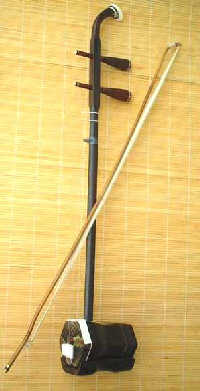| Art Q&A > Music |
|
|
Erhu -- Queen of Chinese Folk Orchestra
The two-stringed, vertical fiddle -- China's answer to the western violin -- has a history of more than 1,000 years. It became popular in southern China during the Song Dynasty (960-1279) when it was called nanhu . Capable of producing music with a flexibility approaching that of the human voice, the erhu is extremely popular in China today as a medium for both traditional and contemporary music and plays an important role in both solo and orchestral performances. Hailed as a Chinese violin, the erhu is quite different from a western fiddle. There is a vertical post with a fingerboard crosses the sides of a resonator at its base. This resonator is covered with a piece of stretched python skin that produces a unique "whining" tone. The erhu bow is placed between its two strings called the inner and outer strings. Traditionally the two strings are made of silk, but metallic strings are also used. An erhu player usually sits with the instrument on his or her left upper thigh in front of the left hip. The erhu is played by moving the bow horizontally over the two vertical strings. The erhu's range spans over three octaves and the tune produced shares some qualities with the violin, although it produces a more nasal tone which is gentle but firm. The erhu resembles a human voice and can imitate many natural sounds, such as birds and horses. It is a very expressive instrument, most known for playing melancholy tunes, but also for its joyful melodies.
|
|||||
All rights reserved. Reproduction of text for non-commercial purposes is permitted provided that both the source and author are acknowledged and a notifying email is sent to us. |
|||||
 |
